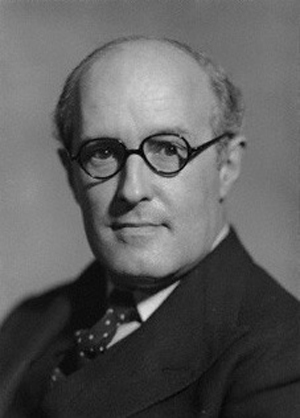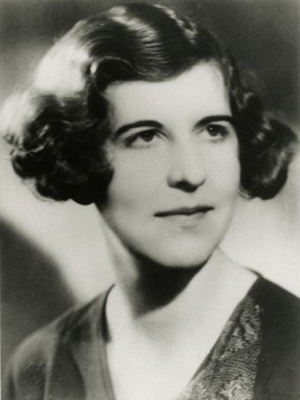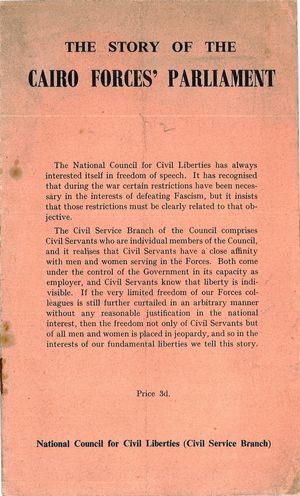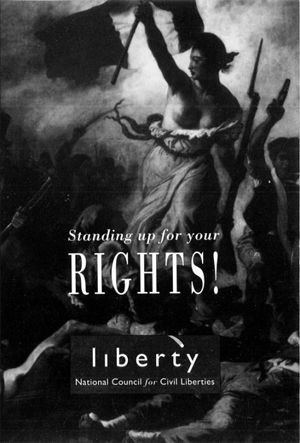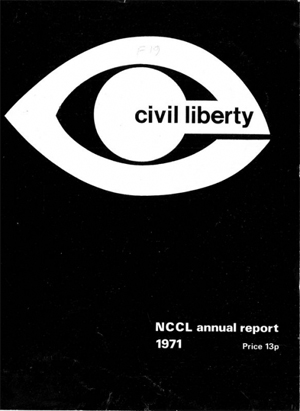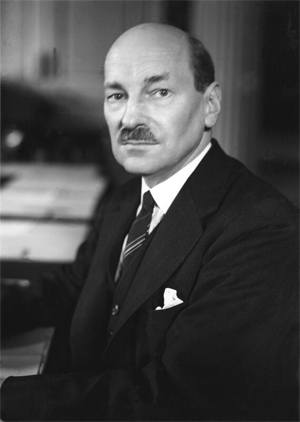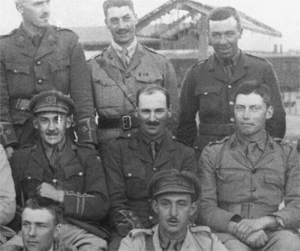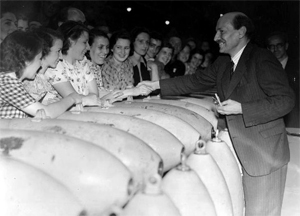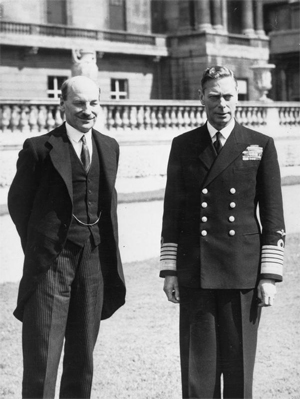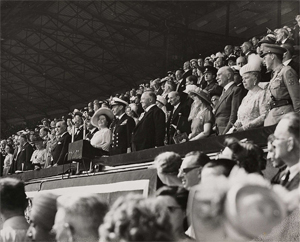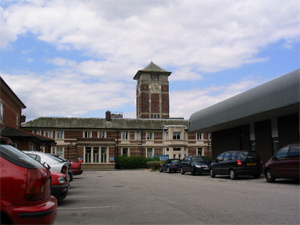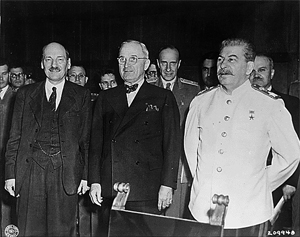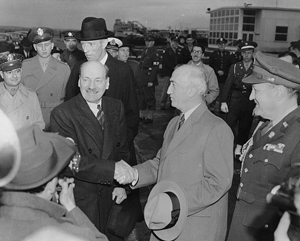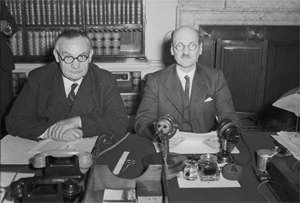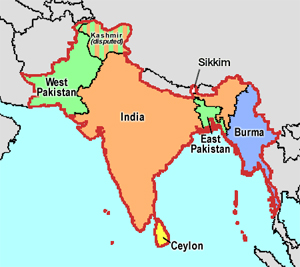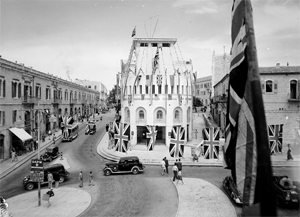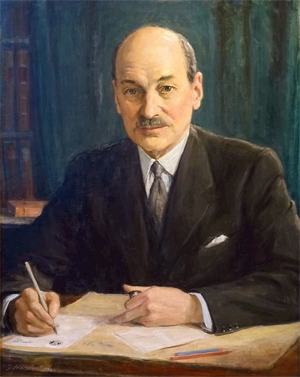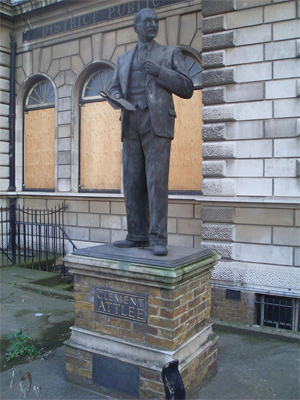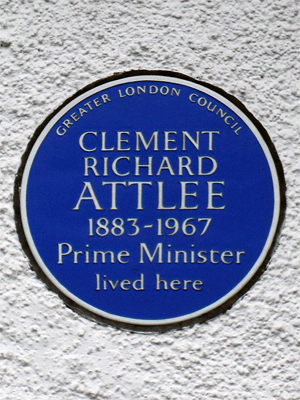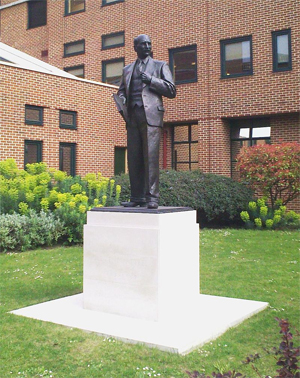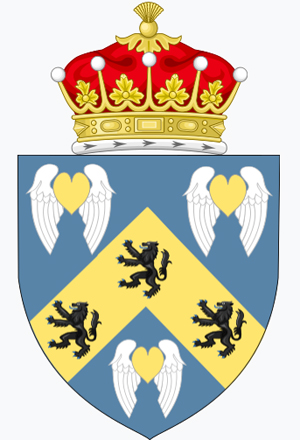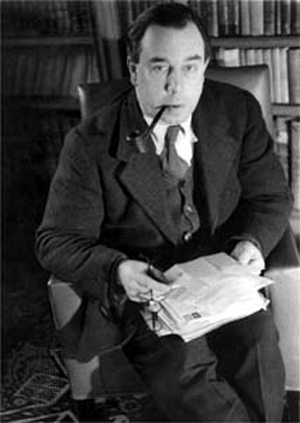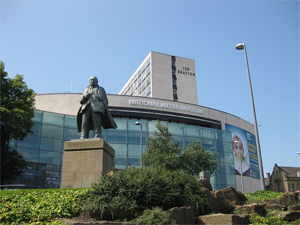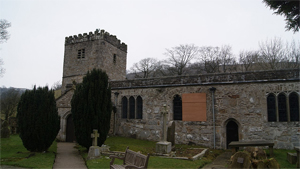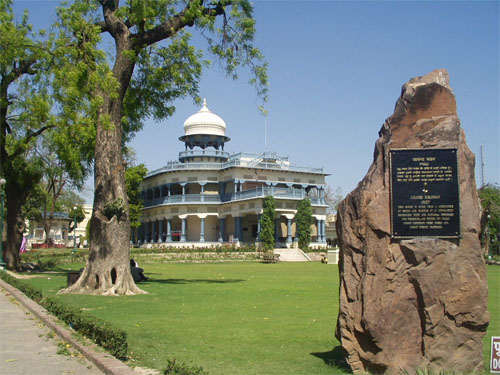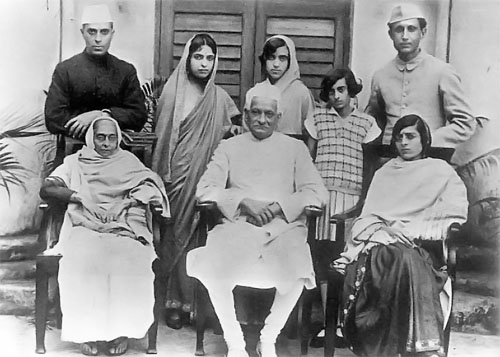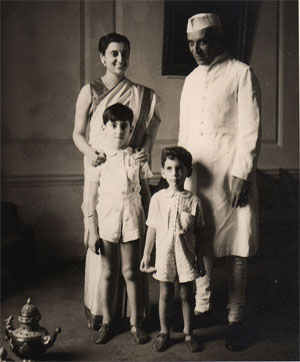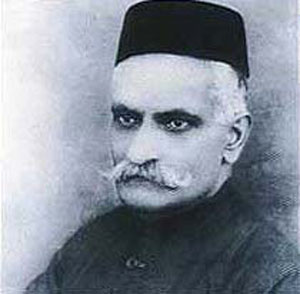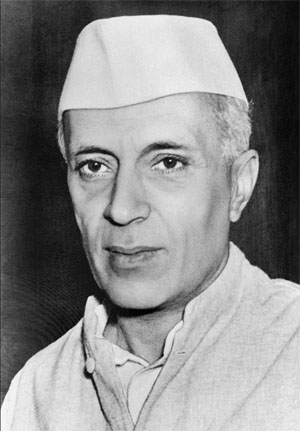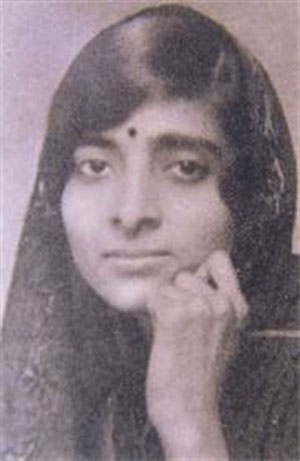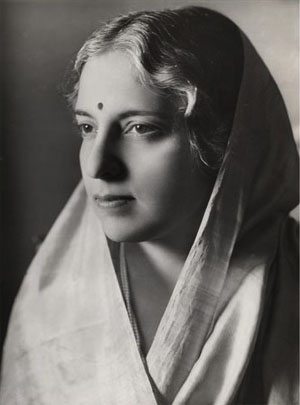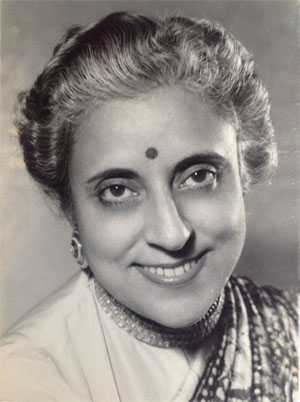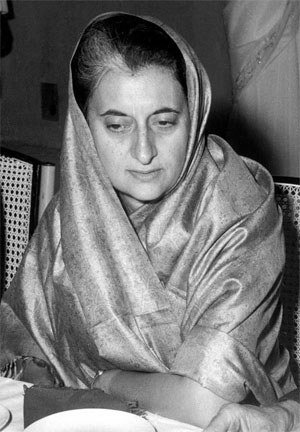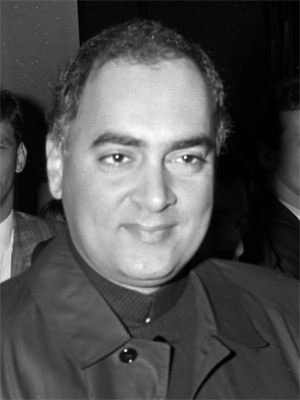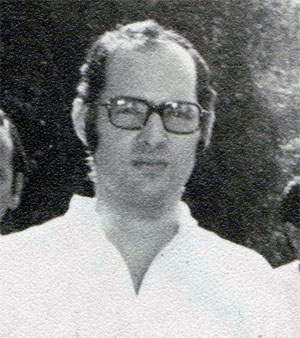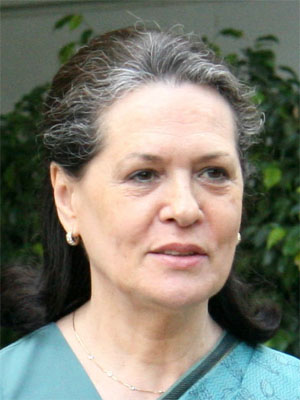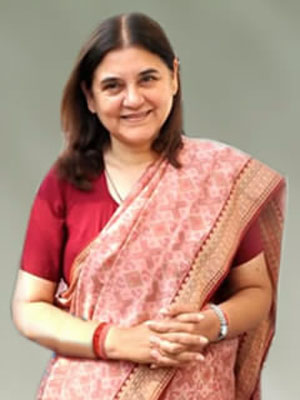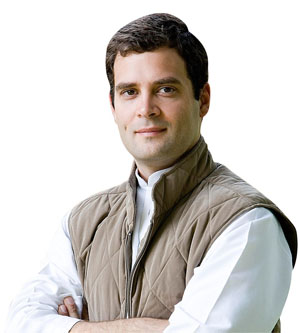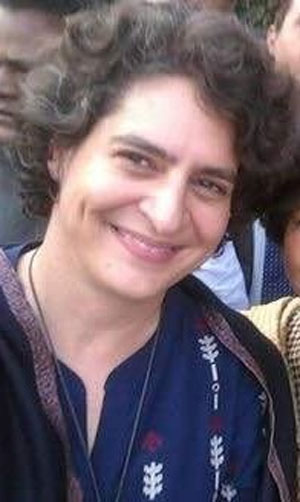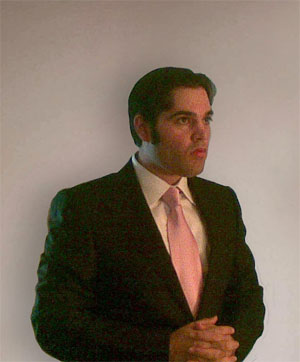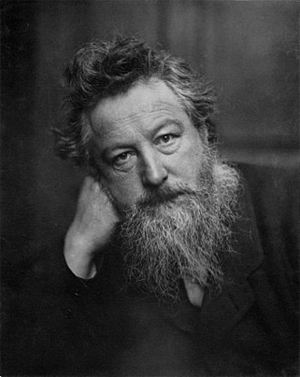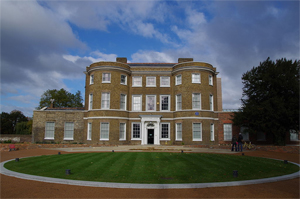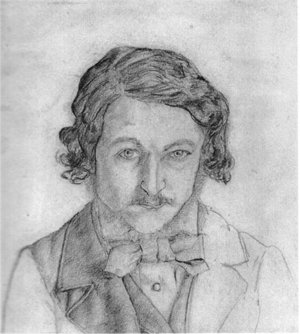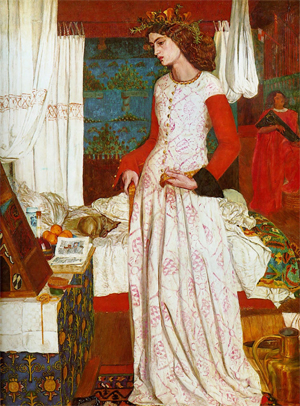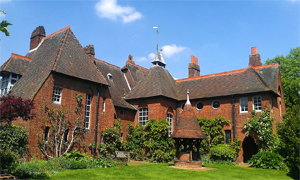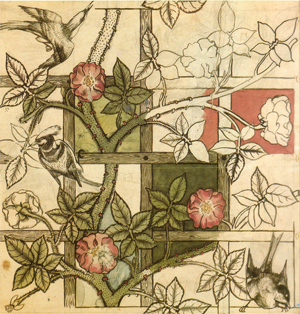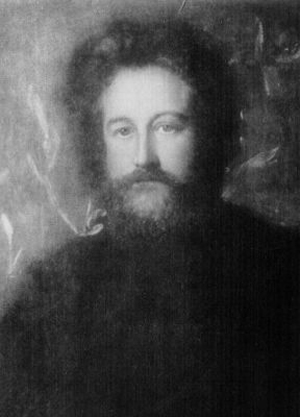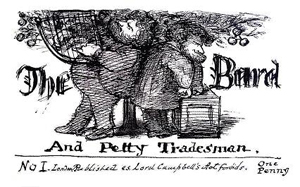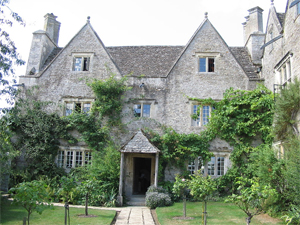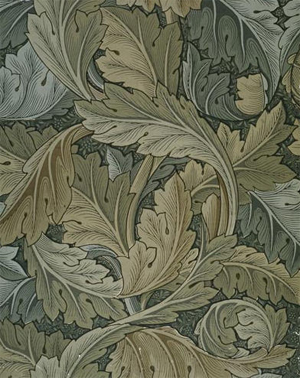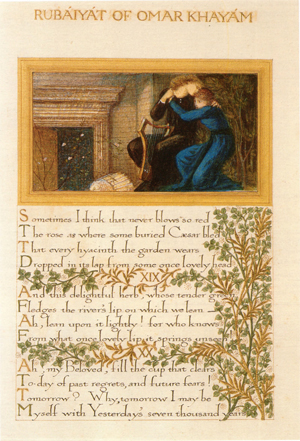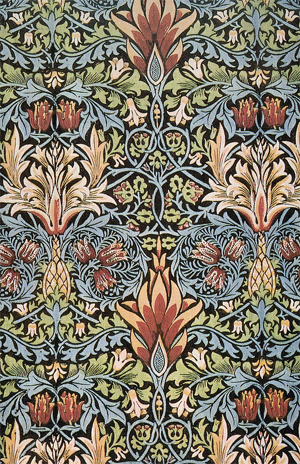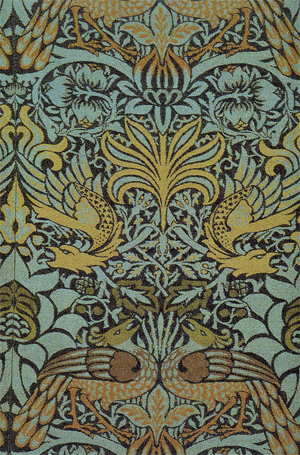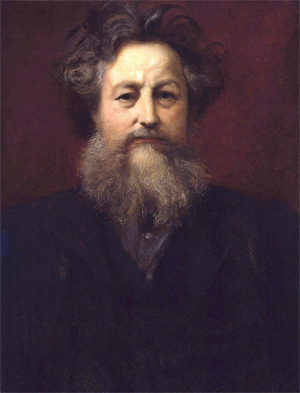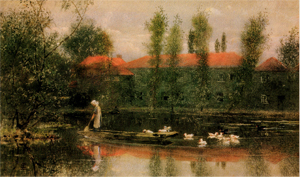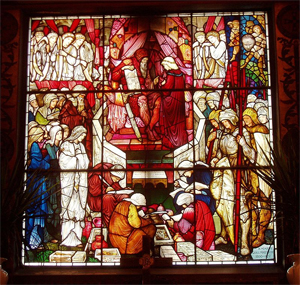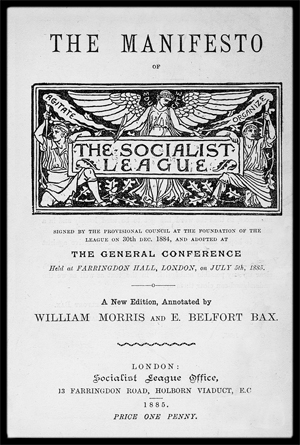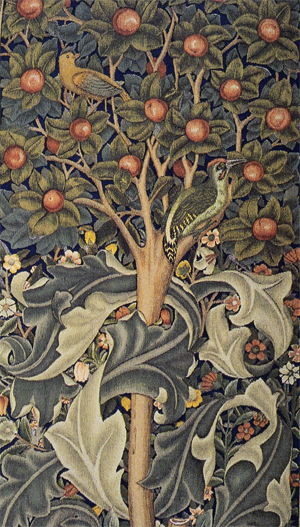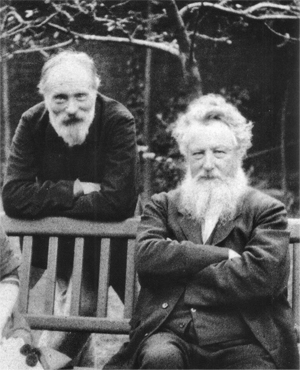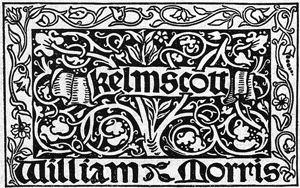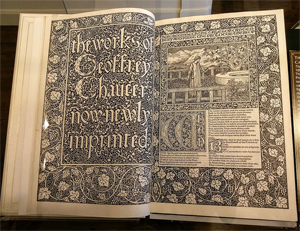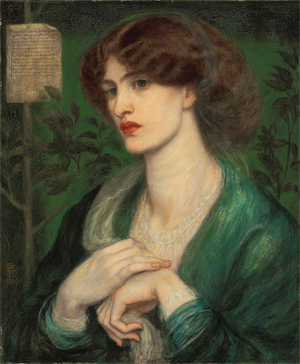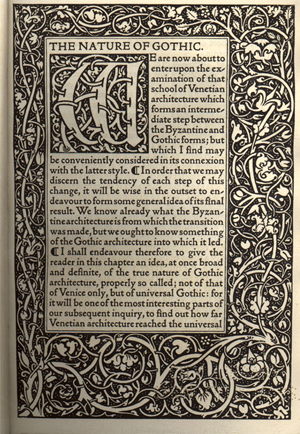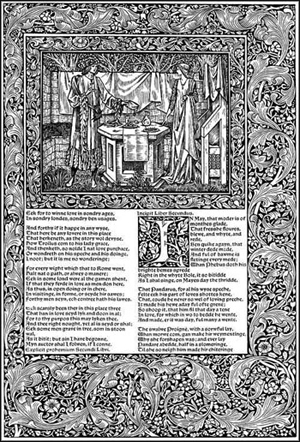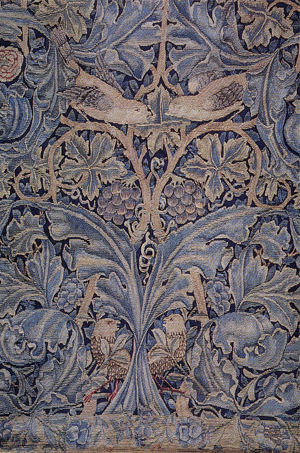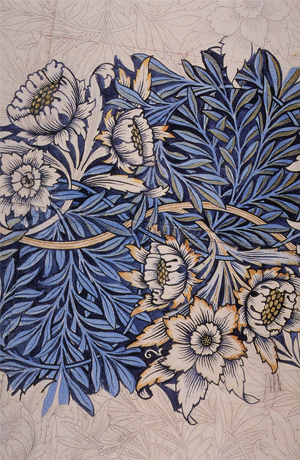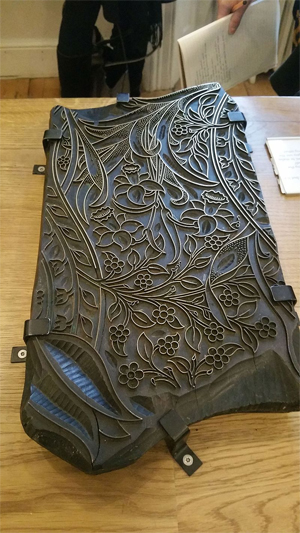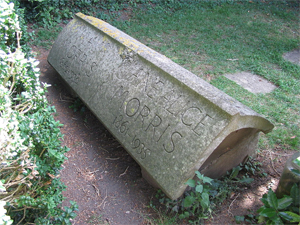by Wikipedia
Accessed: 3/27/20
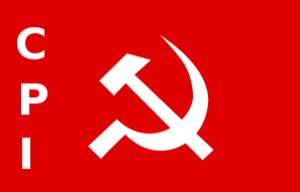
Communist Party of India
Abbreviation: CPI
Secretary: D. Raja[1]
Lok Sabha leader: K. Subbarayan
Rajya Sabha leader: Binoy Viswam
Founder: M.N. Roy; Abani Mukherji; Ahmed Hasan; Hasrat Mohani; Rafiq Ahmed; Sultan Ahmed Khan Tarin
Founded: 26 December 1925 (94 years ago) at Cawnpore, British Raj (presently Kanpur, India)
Headquarters: Ajoy Bhavan, 15, Indrajit Gupta Marg, New Delhi, India-110002
Newspaper: New Age (English); Mukti Sangharsh (Hindi); Janayugom (Malayalam); Kalantar (Bengali); Janasakthi (Tamil); Kholao Thakhai (Manipuri); Prajapaksham (Telugu); Nuadunia (Odia); Kembavuta (Kannada)
Student wing: AISF
Youth wing: AIYF
Women's wing: NFIW
Labour wing: AITUC and BKMU
Peasant's wing: AIKS (AB)
Ideology: Communism[2]; Marxism–Leninism[3]; Socialism[2]; Secularism[2]
Political position: Left-wing[4][5]
International affiliation: IMCWP
Colours: Red
ECI Status: National Party[6]
Alliance: UPA (2004–2008); LF West Bengal; LF Tripura; LDF Kerala; PDA
Seats in Lok Sabha: 2 / 543
Seats in Rajya Sabha: 1 / 245
Seats in: 19 / 140 (Kerala Legislative Assembly (2016); 1 / 294 (West Bengal Legislative Assembly 2016)
Election symbol

Website: https://www.communistparty.in/
The Communist Party of India (CPI) is the oldest communist political party in India, and one of the eight national parties in the country.[7][8] There are different views on exactly when it was founded. The date maintained as the foundation day by the CPI is 26 December 1925.[9] The Communist Party of India (Marxist), also a national party, separated from the CPI in 1964 following an ideological rift between China and the Soviet Union, continues to claim having been founded in 1920. The party remains committed to Marxism–Leninism.[3]
History
Formation
The Communist Party of India has officially stated that it was formed on 26 December 1925 at the first Party Conference in Kanpur, then Cawnpore. S.V. Ghate was the first General Secretary of CPI. But as per the version of CPI (M), the Communist Party of India was founded in Tashkent, Turkestan Autonomous Soviet Socialist Republic on 17 October 1920, soon after the Second Congress of the Communist International. The founding members of the party were M.N. Roy, Evelyn Trent Roy (Roy's wife), Abani Mukherji, Rosa Fitingof (Abani's wife), Mohammad Ali (Ahmed Hasan), Mohammad Shafiq Siddiqui, Hasrat Mohani, Rafiq Ahmed of Bhopal and M.P.T. Aacharya, and Sultan Ahmed Khan Tarin of North-West Frontier Province.[10][11][12] The CPI says that there were many communist groups formed by Indians with the help of foreigners in different parts of the world and the Tashkent group was only one of. contacts with Anushilan and Jugantar groups in Bengal. Small communist groups were formed in Bengal (led by Muzaffar Ahmed), Bombay (led by S.A. Dange), Madras (led by Singaravelu Chettiar), United Provinces (led by Shaukat Usmani) and Punjab and Sindh (led by Ghulam Hussain). However, only Usmani became a CPI party member.[13]
Involvement in independence struggle
During the 1920s and the early 1930s the party was badly organised, and in practice there were several communist groups working with limited national co-ordination. The British colonial authorities had banned all communist activity, which made the task of building a united party very difficult. Between 1921 and 1924 there were three conspiracy trials against the communist movement; First Peshawar Conspiracy Case, Meerut Conspiracy Case and the Kanpur Bolshevik Conspiracy Case. In the first three cases, Russian-trained muhajir communists were put on trial. However, the Cawnpore trial had more political impact. On 17 March 1924, Shripad Amrit Dange, M.N. Roy, Muzaffar Ahmed, Nalini Gupta, Shaukat Usmani, Singaravelu Chettiar, Ghulam Hussain and R.C. Sharma were charged, in Cawnpore (now spelt Kanpur) Bolshevik Conspiracy case. The specific pip charge was that they as communists were seeking "to deprive the King Emperor of his sovereignty of British India, by complete separation of India from imperialistic Britain by a violent revolution." Pages of newspapers daily splashed sensational communist plans and people for the first time learned, on such a large scale, about communism and its doctrines and the aims of the Communist International in India.[14]
Singaravelu Chettiar was released on account of illness. M.N. Roy was in Germany and R.C. Sharma in French Pondichéry, and therefore could not be arrested. Ghulam Hussain confessed that he had received money from the Russians in Kabul and was pardoned. Muzaffar Ahmed, Nalini Gupta, Shaukat Usmani and Dange were sentenced for various terms of imprisonment. This case was responsible for actively introducing communism to a larger Indian audience.[14] Dange was released from prison in 1927. Rahul Dev Pal was a prominent communist leader
On 25 December 1925 a communist conference was organised in Kanpur.[15] Colonial authorities estimated that 500 persons took part in the conference. The conference was convened by a man called Satyabhakta. At the conference Satyabhakta argued for a 'National communism' and against subordination under Comintern. Being outvoted by the other delegates, Satyabhakta left the conference venue in protest. The conference adopted the name 'Communist Party of India'. Groups such as Labour Kisan Party of Hindustan (LKPH) dissolved into the unified CPI.[16] The émigré CPI, which probably had little organic character anyway, was effectively substituted by the organisation now operating inside India.
Soon after the 1926 conference of the Workers and Peasants Party of Bengal, the underground CPI directed its members to join the provincial Workers and Peasants Parties. All open communist activities were carried out through Workers and Peasants Parties.[17]
The sixth congress of the Communist International met in 1928. In 1927 the Kuomintang had turned on the Chinese communists, which led to a review of the policy on forming alliances with the national bourgeoisie in the colonial countries. The Colonial theses of the 6th Comintern congress called upon the Indian communists to combat the 'national-reformist leaders' and to 'unmask the national reformism of the Indian National Congress and oppose all phrases of the Swarajists, Gandhists, etc. about passive resistance'.[18] The congress did however differentiate between the character of the Chinese Kuomintang and the Indian Swarajist Party, considering the latter as neither a reliable ally nor a direct enemy. The congress called on the Indian communists to utilise the contradictions between the national bourgeoisie and the British imperialists.[19] The congress also denounced the WPP. The Tenth Plenum of the Executive Committee of the Communist International, 3 July 1929 – 19 July 1929, directed the Indian communists to break with WPP. When the communists deserted it, the WPP fell apart.[20]
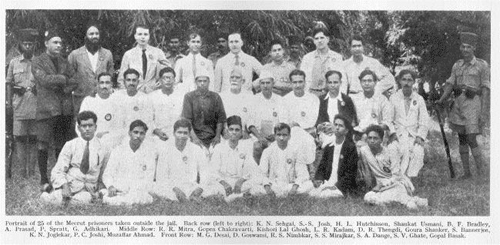
Portrait of 25 of Meerut Prisoners taken outside the jail. Backrow:(left to right) K.N. Sehgal, S.S. Josh, H.L. Hutchinson, Shaukat Usmani, B.F. Bradly, A. Prasad, Philip Spratt, and G. Adhikari. Middle Row: K.R. Mitra, Gopan Chakravarthy, Kishore Lal Ghosh, K.L. Kadam, D.R. Thengdi, Goura Shanker, S. Banerjee, K.N. Joglekar, Puran Chand Joshi, and Muzaffar Ahmed. Front Row: M.G. Desai, G. Goswami, R.S. Nimkar, S.S. Mirajkar, S.A. Dange, S.V. Ghate and Gopal Basak.
On 20 March 1929, arrests against WPP, CPI and other labour leaders were made in several parts of India, in what became known as the Meerut Conspiracy Case. The communist leadership was now put behind bars. The trial proceedings were to last for four years.[21][22]
As of 1934, the main centres of activity of CPI were Bombay, Calcutta and Punjab. The party had also begun extending its activities to Madras. A group of Andhra and Tamil students, amongst them P. Sundarayya, were recruited to the CPI by Amir Hyder Khan.[23]
The party was reorganised in 1933, after the communist leaders from the Meerut trials were released. A central committee of the party was set up. In 1934 the party was accepted as the Indian section of the Communist International.[24]
When Indian leftwing elements formed the Congress Socialist Party in 1934, the CPI branded it as Social Fascist.[18]
The League Against Gandhism, initially known as the Gandhi Boycott Committee, was a political organisation in Calcutta, founded by the underground Communist Party of India and others to launch militant anti-Imperialist activities. The group took the name ‘League Against Gandhism’ in 1934.[25]
In connection with the change of policy of the Comintern toward Popular Front politics, the Indian communists changed their relation to the Indian National Congress. The communists joined the Congress Socialist Party, which worked as the left wing of Congress. Through joining CSP, the CPI accepted the CSP demand for a Constituent Assembly, which it had denounced two years before. The CPI however analysed that the demand for a Constituent Assembly would not be a substitute for soviets.[26]
In July 1937, the first Kerala unit of CPI was founded at a clandestine meeting in Calicut. Five persons were present at the meeting, P. Krishna Pillai E.M.S. Namboodiripad, N.C. Sekhar, K. Damodaran and S.V. Ghate. The first four were members of the CSP in Kerala. The latter, Ghate, was a CPI Central Committee member, who had arrived from Madras.[27] Contacts between the CSP in Kerala and the CPI had begun in 1935, when P. Sundarayya (CC member of CPI, based in Madras at the time) met with EMS and Krishna Pillai. Sundarayya and Ghate visited Kerala at several times and met with the CSP leaders there. The contacts were facilitated through the national meetings of the Congress, CSP and All India Kisan Sabha.[23]
In 1936–1937, the co-operation between socialists and communists reached its peak. At the 2nd congress of the CSP, held in Meerut in January 1936, a thesis was adopted which declared that there was a need to build 'a united Indian Socialist Party based on Marxism-Leninism'.[28] At the 3rd CSP congress, held in Faizpur, several communists were included into the CSP National Executive Committee.[29]
In Kerala communists won control over CSP, and for a brief period controlled Congress there.
Two communists, E.M.S. Namboodiripad and Z.A. Ahmed, became All India joint secretaries of CSP. The CPI also had two other members inside the CSP executive.[26]
On the occasion of the 1940 Ramgarh Congress Conference CPI released a declaration called Proletarian Path, which sought to utilise the weakened state of the British Empire in the time of war and gave a call for general strike, no-tax, no-rent policies and mobilising for an armed revolutionary uprising. The National Executive of the CSP assembled at Ramgarh took a decision that all communists were expelled from CSP.[30]
In July 1942, the CPI was legalised, as a result of Britain and the Soviet Union becoming allies against Nazi Germany.[31] Communists strengthened their control over the All India Trade Union Congress. At the same time, communists were politically cornered for their opposition to the Quit India Movement.
CPI contested the Provincial Legislative Assembly elections of 1946 of its own. It had candidates in 108 out of 1585 seats. It won in eight seats. In total the CPI vote counted 666 723, which should be seen with the backdrop that 86% of the adult population of India lacked voting rights. The party had contested three seats in Bengal, and won all of them. One CPI candidate, Somnath Lahiri, was elected to the Constituent Assembly.[32]
After independence
During the period around and directly following Independence in 1947, the internal situation in the party was chaotic. The party shifted rapidly between left-wing and right-wing positions. In February 1948, at the 2nd Party Congress in Calcutta, B. T. Ranadive (BTR) was elected General Secretary of the party.[33] The conference adopted the 'Programme of Democratic Revolution'. This programme included the first mention of struggle against caste injustice in a CPI document.[34]
In several areas the party led armed struggles against a series of local monarchs that were reluctant to give up their power. Such insurgencies took place in Tripura, Telangana and Kerala.[citation needed] The most important rebellion took place in Telangana, against the Nizam of Hyderabad. The Communists built up a people's army and militia and controlled an area with a population of three million. The rebellion was brutally crushed and the party abandoned the policy of armed struggle. BTR was deposed and denounced as a 'left adventurist'.
In Manipur, the party became a force to reckon with through the agrarian struggles led by Jananeta Irawat Singh. Singh had joined CPI in 1946.[35] At the 1951 congress of the party, 'People's Democracy' was substituted by 'National Democracy' as the main slogan of the party.[36]
Communist Party was founded in Bihar in 1939. Post independence, communist party achieved success in Bihar (Bihar and Jharkhand). Communist party conducted movements for land reform, trade union movement was at its peak in Bihar in the sixties, seventies and eighties. Achievement of communists in Bihar placed the communist party in the forefront of left movement in India. Bihar produced some of the legendary leaders like Kishan leaders Sahjanand Saraswati and Karyanand Sharma, intellectual giants like Jagannath Sarkar, Yogendra Sharma and Indradeep Sinha, mass leaders like Chandrashekhar Singh and Sunil Mukherjee, Trade Union leaders like Kedar Das and others. It was in Bihar that JP's total revolution was exposed and communist party under the leadership of Jagannath Sarkar fought Total Revolution and exposed its hollowness. "Many Streams" Selected Essays by Jagannath Sarkar and Reminiscing Sketches, Compiled by Gautam Sarkar, Edited by Mitali Sarkar, First Published : May 2010, Navakaranataka Publications Pvt. Ltd., Bangalore . In the Mithila region of Bihar Bhogendra Jha led the fight against the Mahants and Zamindars. He later went on the win Parliamentary elections and was MP for seven terms.
In early 1950s young communist leadership was uniting textile workers, bank employees and unorganised sector workers to ensure mass support in north India. National leaders like S A Dange, Chandra Rajeswara Rao and P K Vasudevan Nair were encouraging them and supporting the idea despite their differences on the execution. Firebrand Communist leaders like Homi F. Daji, Guru Radha Kishan, H L Parwana, Sarjoo Pandey, Darshan Singh Canadian and Avtaar Singh Malhotra were emerging between the masses and the working class in particular. This was the first leadership of communists that was very close to the masses and people consider them champions of the cause of the workers and the poor. In Delhi, May Day (majdoor diwas or mai diwas) was organised at Chandni Chowk Ghantaghar in such a manner that demonstrates the unity between all the factions of working classes and ignite the passion for communist movement in the northern part of India.
In 1952, CPI became the first leading opposition party in the Lok Sabha, while the Indian National Congress was in power.
Communist movement or CPI in particular emerged as a front runner after Guru Radha Kishan undertook a fast unto death for 24 days to promote the cause of textile workers in Delhi. Till than it was a public misconception that communists are revolutionaries with arms in their hands and workers and their families were afraid to get associated with the communists but this act mobilised general public in the favour of communist movement as a whole. During this period people with their families used to visit 'dharna sthal' to encourage CPI cadre.
This model of selflessness for the society worked for the CPI far more than what was expected. This trend was followed by almost all other state units of the party in the Hindi heartland. Communist Party related trade union AITUC became a prominent force to unite the workers in textile, municipal and unorganised sectors, the first labour union in unorganised sector was also emerged in the leadership of Comrade Guru Radha Kishan during this period in Delhi's Sadar Bazaar area. This movement of mass polarisation of workers in the favour of CPI worked effectively in Delhi and paved the way for great success of CPI in the elections in working class dominated areas in Delhi. Comrade Gangadhar Adhikari and E.M.S. Namboodiripad applauded this brigade of dynamic comrades for their selfless approach and organisational capabilities. This brigade of firebrand communists gained more prominence when Telangana hero Chandra Rajeswara Rao rose to be General Secretary of the Communist Party of India.
In the 1952 Travancore-Cochin Legislative Assembly election, Communist Party was banned, so it couldn't take part in the election process.[37] In the general elections in 1957, the CPI emerged as the largest opposition party. In 1957, the CPI won the state elections in Kerala. This was the first time that an opposition party won control over an Indian state. E. M. S. Namboodiripad became Chief Minister. At the 1957 international meeting of Communist parties in Moscow, the Communist Party of China directed criticism at the CPI for having formed a ministry in Kerala.[38]
Ideological differences lead to the split in the party in 1964 when two different party conferences were held, one of CPI and one of the Communist Party of India (Marxist). There is a common misconception that the rift during the Sino-Indian war, when Communist Party Of India proudly supported China in the war led to the 1962 split.[citation needed] In fact, the split was leftists vs rightists, rather than internationalists vs nationalists.[citation needed] The presence of nationalists in CPI, and internationalists P. Sundarayya, Jyoti Basu, and Harkishan Singh Surjeet in the Communist Party of India (Marxist) proves this fact.
During the period 1970–77, CPI was allied with the Congress party. In Kerala, they formed a government together with Congress, with the CPI-leader C. Achutha Menon as Chief Minister. After the fall of the regime of Indira Gandhi, CPI reoriented itself towards co-operation with CPI(M).
In 1986, the CPI's leader in the Punjab and MLA in the Punjabi legislature Darshan Singh Canadian was assassinated by Sikh extremists. Then on 19 May 1987, Deepak Dhawan, General Secretary of Punjab CPI(M), was murdered. Altogether about 200 communist leaders out of which most were Sikhs were killed by Sikh extremists in Punjab.[citation needed]
Present situation
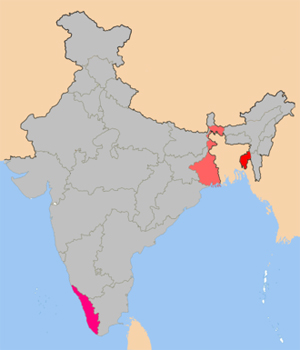
[RED] State/s which had a chief minister from the Communist Party of India (CPI).
[ORANGE] State/s which had a chief minister from the CPI-M.
[MAROON] State/s which had chief ministers from both the CPI-M and the Communist Party of India (CPI).
[GREY] States which did not have/had a chief minister from the CPI-M or the CPI.
[WHITE] Union territories without a state government.
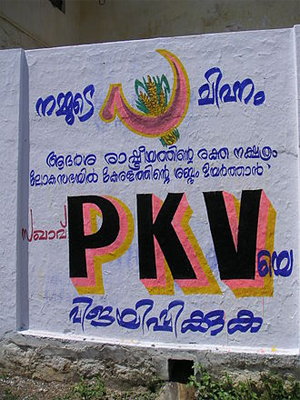
Mural in Thiruvananthapuram
CPI was recognised by the Election Commission of India as a 'National Party'. To date, CPI happens to be the only national political party from India to have contested all the general elections using the same electoral symbol. Owing to a massive defeat in 2019 Indian general election where the party saw its tally reduce to 2 MP, the Election Commission of India has sent a letter to CPI asking for reasons why its national party status should not be revoked.[39][40][41][42][43] If similar performance is repeated in the next election, the CPI will no longer be a national party.
On the national level they supported the Indian National Congress-led United Progressive Alliance government along with other parliamentary Left parties, but without taking part in it. Upon attaining power in May 2004, the United Progressive Alliance formulated a programme of action known as the Common Minimum Programme. The Left bases its support to the UPA on strict adherence to it. Provisions of the CMP mentioned to discontinue disinvestment, massive social sector outlays and an independent foreign policy.
On 8 July 2008, the General Secretary of CPI(M), Prakash Karat, announced that the Left was withdrawing its support over the decision by the government to go ahead with the United States-India Peaceful Atomic Energy Cooperation Act. The Left parties combination had been a staunch advocate of not proceeding with this deal citing national interests.[44]
In West Bengal it participates in the Left Front. It also participated in the state government in Manipur. In Kerala the party is part of Left Democratic Front. In Tripura the party is a partner of the Left Front, which governed the state till 2018. In Tamil Nadu it is part of the Progressive Democratic Alliance. It is involved in the Left Democratic Front in Maharashtra
The current general secretary of CPI is D. Raja.
Party Congress
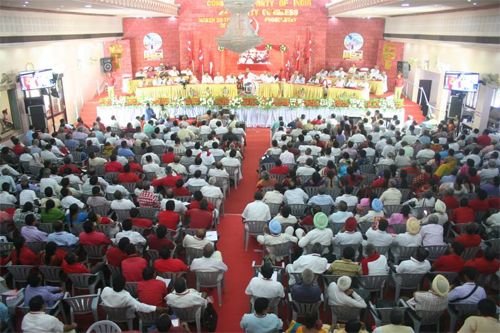
22nd Congress of Communist Party of India being held in Pondicherry
Party Congress / Year / Place
1 / 1925 December 25 to 28 / Kanpur [45]
2 / 1948 February 28 to March 27 / Calcutta
3 / 1953 December 27 to January 4 / Madhura
4 / 1956 April 19 to 29 / Palakkad
5 / 1958 April 6 to 13 / Amritsar
6 / 1961 April 7 to 16 / Vijayawada
7 / 1964 December 13-23 / Bombay
8 / 1968 February 7–15 / Patna
9 / 1971 October / Cochin
10 / 1975 January 27 - 2 February / Vijayawada
11 / 1978 March 31-April 7 / Bathinda
12 / 1982 March 22 to 28 / Varanasi
13 / 1986 March 2 to 17 / Patna
14 / 1989 March 6–12 / Calcutta
15 / 1992 April 10 to 16 / Hyderabad
16 / 1995 October / Delhi
17 / 1998 September 14-19 / Chennai
18 / 2002 March 26 to 31 / Thiruvananthapuram
19 / 2005 March 29 0 April 3 / Chandigarh
20 / 2008 March 23–27 / Hyderabad
21 / 2012 March 27–31 / Patna
22 / 2015 March 25–29 / Pondicherry
23 / 2018 April 25–29 / Kollam
Leadership
Newly Elected CPI National Leadership The following are the members of the Central Control Commission, National Council and Candidate Members to National Council, National Executive, National Secretariat and Party Programme Commission elected at the 23rd Party Congress of Communist Party of India held from 25 to 29 April 2018 in Kollam, Kerala:
Central Control Commission
1. Pannian Ravindran (Chairman)
2. C.A. Kurien
3. Dr Joginder Dayal (Punjab)
4. C.R. Bakshi (Chattisgarh)
5. P.J.C. Rao (Andhra Pradesh)
6. Bijoy Narayan Mishra (Bihar)
7. Moti Lal (Uttar Pradesh)
8. M. Sakhi Devi (Tripura)
9. T. Narsimhan (Telangana)
10. M. Arumugham (Tamil Nadu)
11. Apurba Mandal (West Bengal)
National Council Members
• S. Sudhakar Reddy
• Gurudas Dasgupta
• D. Raja
• Shameem Faizee
• Atul Kumar Anjaan
• Ramendra Kumar
• Amarjeet Kaur
• Dr. K. Narayana
• Nagendranath Ojha
• Dr. B.K. Kango
• Binoy Viswam
• Pallab Sengutpa
• Kanhaiya Kumar
• Azeez Pasha
• Annie Raja - Women Front
• CH Venkatachalam - Bank Front
• B.V. Vijaylakshmi - TU Front
• S. V. Damle - TU Front
• Vidyasagar Giri - TU Front
• R.S. Yadav - Mukti Sangharsh
• Manish Kunjam - Tribal Front
• C. Srikumar - Defence
• Gargi Chakravarthy - Women Front
• Anil Rajimwale - Education Department
• Viswajeet Kumar - Student Front
• R. Thirumalai - Youth Front
• A.A. Khan - Minority Front
Andhra Pradesh
• K. Ramakrishna
• M.N. Rao
• J.V.S.N. Murthy
• Jalli Wilson
• Akkineni Vanaja
Assam
• Munin Mahanta
• Kanak Gogoi
Bihar
• Satya Narayan Singh
• Ram Naresh Pandey
• Janki Paswan
• Jabbar Alam
• Rajendra Prasad Singh
• Rageshri Kiran
• Om Prakash Narayan
• Pramod Prabhakar
• Ram Chandra Singh
• Nivedita
Chhattisgarh
• R.D.C.P. Rao
• Rama Sori
Delhi
• Dhirendra K. Sharma
• Prof. Dinesh Varshney
Goa
• Chirstopher Fonseca
Gujarat
• Raj Kumar Singh
• Vijay Shenmare
Haryana
• Dariyao Singh Kashyap
Himachal Pradesh
• Shayam Singh Chauhan
Jharkhand
• Bhubaneshwar Prasad Mehta
• K.D. Singh
• Rajendra Prasad Yadav
• Mahendra Pathak
Jammu and Kashmir
Vacant
Karnataka
• P.V. Lokesh
• Saathi Sundaresh
Kerala
• Kanam Rajendran
• K.E. Ismail
• K. Prekash Babu
• E. Chandrasekharan
• Adv. P. Vasantham
• T.V. Balan
• C.N. Jayadevan
• K.P. Rajendran
• J. Chinju Rani
• Adv. N. Anirudhan
• Adv. Rajan
Manipur
• M. Nara Singh
• L. Sotin Kumar
Meghalaya
• Samudra Gupta
Maharashtra
• Tukaram Bhasme
• Namdev Gavade
• Ram Baheti
• Prakash Reddy
Madhya Pradesh
• Arvind Shrivastava
• Haridwar Singh
Odisha
• Dibakar Nayak
• Ashish Kanungo
• Abhaya Sahoo
• Ramakrushna Panda
• Souribandhu Kar
Puducherry
• A.M. Saleem
• A. Ramamoorthy
Punjab
• Bant Singh Brar
• Jagrup Singh
• Hardev Singh Arshi
• Nirmal Singh Dhaliwal
• Jagjit Singh Joga
Rajasthan
• Narendra Acharya
• Tara Singh Sidhu
Tripura
Vacant
Tamil Nadu
• R. Nallakkannu
• D. Pandian
• R. Mutharasan
• C. Mahendran
• K. Subbarayan
• M. Veerapandian
• T.M. Murthi
• G. Palaniswamy
• P. Padmavathi
• P. Sethuraman
Telangana
• Chada Venkat Reddy
• Palla Venkat Reddy
• K. Sambasiva Rao
• Pasya Padma
• K. Srinivas Reddy
• K. Shanker
• T. Srinivas Rao
Uttar Pradesh
• Dr. Girish Sharma
• Arvind Raj Swarup
• Imtiyaz Ahmed
• Prof. Nisha Rathor
• Ram Chand Saras
Uttarakhand
• Samar Bhandari
West Bengal
• Swapan Banerjee
• Manju Kumar Mazumdar
• Santosh Rana
• Shyama Sree Das
• Ujjawal Chaudhury
• Chittaranjan Das Thakur
• Prabir Deb
• Tarun Das
Candidate Members
• Krishna Jha (New Age)
• Prof. Arun Kumar (Teachers)
• Aftab Alam Khan (Youth Front)
• Wali – Ullah – Khadri (Student Front)
• N. Chidambaram (New Age/Office)
• Dr. Arun Mitra (Doctor’s Front)
• M. Bal Narsima (Telangana)
• Mithlesh Jha (Bihar)
• Suhaas Naik (Goa)
• Mahesh Kakkath (Kerala)
• Kh. Surchand Singh (Manipur)
• Richard B. Thabah (Meghalaya)
• G. Obulesu (Andhra Pradesh)
Invitee Members Lakshdweep
National Executive
1. S. Sudhakar Reddy
2. D. Raja
3. Shameem Faizee
4. Atul Kumar Anjaan
5. Amarjeet Kaur
6. Ramendra Kumar
7. Dr. K. Narayana
8. Kanam Rajendran
9. Binoy Viswam
10. Dr. B.K. Kango
11. Pallab Sengupta
12. Nagendra Nath Ojha
13. Dr. Girish Sharma
14. Annie Raja
15. Azeez Pasha
16. K. Ramakrishna
17. Satya Narayan Singh
18. Janaki Paswan
19. Ram Naresh Pandey
20. Bhubaneshwar Prasad Mehta
21. K.E. Ismail
22. Dr. M. Nara Singh
23. Dibakar Naik
24. R. Mutharasan
25. C. Mahendran
26. Chada Venkata Reddy
27. K. Subbarayan
28. Swapan Banerjee
29. Bant Singh Brar
30. Munin Mahanto
31. C.H. Venkatachalam
Ex-Officio Members
1. Pannian Ravindran (Chairperson, Central Control Commission)
2. Gurudas Dasgupta (Chairman, Permanent Programme Commission)
National Secretariat
1. S. Sudhakar Reddy
2. D. Raja
3. Shameem Faizee
4. Atul Kumar Anjaan
5. Amarjeet Kaur
6. Ramendra Kumar
7. Dr. K. Narayana
8. Kanam Rajendran
9. Binoy Viswam
10. Dr. B.K. Kango
11. Pallab Sen Gupta
Party Programme Commission
1. Gurudas Dasgupta (Chairman)
2. Pallab Sen Gupta (Secretary)
3. Prekash Babu
4. C.R. Bakshi
5. Dr. Nara Singh
6. Anil Rajimwale
State Committee secretaries
• Andhra Pradesh : K.Ramakrishna
• Assam : Munin Mahanta
• Bihar : Satya Narayan Singh
• Chhattisgarh : RDCP Rao
• Delhi
• Goa : RD Mangueshkar
• Gujarat : Rajkumar Singh
• Haryana : Dariyao Singh Kashyap
• Himachal Pradesh : Shayam Singh Chauhan
• Jharkhand : Bhubneshwar Prasad Mehta
• Kerala : Kanam Rajendran
• Karnataka : Saathi Sundaresh
• Maharashtra : Tukaram Bhasme
• Madhya Pradesh : Arvind Shrivastava
• Manipur : L. Sotin Kumar
• Meghalaya : Samudra Gupta
• Odisha : Ashish Kanungo
• Puducherry : A.M. Saleem
• Punjab : Bant Singh Brar
• Rajasthan : Narendra Acharya
• Tamilnadu : R. Mutharasan
• Telangana : Chada Venkat Reddy
• Uttar Pradesh : Dr. Girish Sharma
• Uttarakhand : Samar Bhandari
• West Bengal : Swapan Banerjee
Principal mass organisations
• All India Trade Union Congress (AITUC)
• All India Youth Federation (AIYF)
• All India Students Federation (AISF)
• National Federation of Indian Women (NFIW)
• All India Kisan Sabha - AIKS (peasants organisation)
• Bharatiya Khet Mazdoor Union - BKMU (agricultural workers)
• Indian People's Theatre Association - IPTA (cultural wing)
• All India State Government Employees Federation (State government employees)
• Indian Society for Cultural Co-operation and Friendship (ISCUF)
• All India Peace and Solidarity Organization (AIPSO)
General Secretaries
• Sachchidanand Vishnu Ghate
• Gangadhar Adhikari
• Puran Chand Joshi
• B. T. Ranadive
• Chandra Rajeswara Rao
• Ajoy Ghosh
• E. M. S. Namboodiripad
• Indrajit Gupta
• Ardhendu Bhushan Bardhan
• Suravaram Sudhakar Reddy
• D Raja (Present)
Notable leaders
• N.E. Balaram - Founding leader of the communist movement in Kerala, India
• Mohit Banerji (Mohit Bandopadhay) (1912–1961)
• M. N. Govindan Nair – Kerala state secretary during the first communist ministry and a freedom fighter
• C. Achutha Menon – Finance minister in first Kerala ministry Former chief minister of Kerala
• Hasrat Mohani – founding member
• T. V. Thomas – Minister in first Kerala ministry
• M. Kalyanasundaram – Parliamentarian
• P. K. Vasudevan Nair – Ex. Chief minister of Kerala,Former AISF general secretary,Former AIYF general secretary
• Puran Chand Joshi – first general secretary of the Communist Party of India
• Indrajit Gupta – Parliamentarian, former general secretary and a former central minister
• Bhupesh Gupta – Parliamentarian
• Ajoy Ghosh – Former general secretary of CPI, freedom fighter
• Chandra Rajeswara Rao – former general secretary, Telangana freedom fighter
• Jagannath Sarkar – former National Secretary, freedom fighter, builder of communist movement in Bihar and Jharkhand
• Hirendranath Mukherjee-Parliamentarian & He was awarded Padma Bhushan in 1990 and Padma Vibhushan in 1991 by the President of India for his lifelong services.
• Geeta Mukherjee - Parliamentarian & Former President of National Federation of Indian Women
• Ardhendu Bhushan Bardhan – Former general secretary & Parliamentarian
• Chaturanan Mishra parliamentarian & former Central Minister of India
• Gurudas Dasgupta - Parliamentarian & Former General Secretary of the All India Trade Union Congress (AITUC) .
• Suravaram Sudhakar Reddy – current general secretary of the party
• D. Raja – parliamentarian & secretary of the party
• Shripad Amrit Dange – Freedom fighter & former chairman of the party
• Hijam Irabot – Founder leader of CPI in Manipur
• P. S. Sreenivasan – Former minister of Kerala
• C. K. Chandrappan – Parliamentarian & former Kerala state secretary of the party
• Annabhau Sathe - Samyukta Maharashtra movement leader
• Pannyan Raveendran – Former Kerala state secretary of the party
• Kanam Rajendran – Current Kerala state secretary of the party
• Nallakannu – Parliamentarian & former Tamil Nadu state secretary of the party
• D. Pandian - Parliamentarian & former Tamil Nadu state secretary
• Binoy Viswam – Member of Rajya Sabha, Former minister in the Government of Kerala
• Bhalchandra Kango - Veteran Trade Unionist, Marxist Thinker, CPI National Secretariat Member
• Thoppil Bhasi – Writer, film director & parliamentarian
• Veliyam Bharghavan – Parliamentarian & Former Kerala state secretary of the party
• E. Chandrasekharan Nair – Senior leader and Former Minister in the Government of Kerala
• Ramendra Kumar – Former Parliamentarian, national executive member, national president AITUC
• Meghraj Tawar – Udaipur district secretary
• Govind Pansare – Prominent activist and lawyer
• R.Sugathan - Prominent trade unionist, mass leader and member of Kerala Legislative assembly
• Kanhaiya Kumar - CPI National Council Member, Ex JNUSU President, Leader of AISF National Council
• C. Divakaran - Senior leader, former minister and National Council Member from Kerala
• C. N. Jayadevan - Senior leader, parliamentarian
• Rajaji Mathew Thomas - Journalist, former MLA and CPI National council Member, from Kerala
• Chittayam Gopakumar - Kerala MLA and State council member
Former Chief Ministers
• E. M. S. Namboodiripad(First communist Government Kerala 1957-1959)
• C. Achutha Menon-Kerala(1969-1970)(1970-1977)
• P. K. Vasudevan Nair-Kerala(1978-1979)
Lok Sabha election tally
Performance of Communist Party of India in Lok Sabha elections
Lok Sabha / Year / Lok Sabha constituencies / Seats Contested / Won / Net Change in seats / Votes / Votes % / Change in vote % / Reference
First 1952 489 49 16 - 3,487,401 3.29% - [48]
Second 1957 494 109 27 Increase 11 10,754,075 8.92% Increase 5.63% [49]
Third 1962 494 137 29 Increase 02 11,450,037 9.94% Increase 1.02% [50]
Fourth 1967 520 109 23 Decrease 06 7,458,396 5.11% Decrease 4.83% [51]
Fifth 1971 518 87 23 Steady 00 6,933,627 4.73% Decrease 0.38% [52]
Sixth 1977 542 91 7 Decrease 16 5,322,088 2.82% Decrease 1.91% [53]
Seventh 1980 529 ( 542* ) 47 10 Increase 03 4,927,342 2.49% Decrease 0.33% [54]
Eighth 1984 541 66 6 Decrease 04 6,733,117 2.70% Increase 0.21% [55][56]
Ninth 1989 529 50 12 Increase 06 7,734,697 2.57% Decrease 0.13% [57]
Tenth 1991 534 43 14 Increase 02 6,898,340 2.48% Decrease 0.09% [58][59]
Eleventh 1996 543 43 12 Decrease 02 6,582,263 1.97% Decrease 0.51% [60]
Twelfth 1998 543 58 09 Decrease 03 6,429,569 1.75% Decrease 0.22% [61]
Thirteenth 1999 543 54 04 Decrease 05 5,395,119 1.48% Decrease 0.27% [62]
Fourteenth 2004 543 34 10 Increase 06 5,484,111 1.41% Decrease 0.07% [63]
Fifteenth 2009 543 56 04 Decrease 06 5,951,888 1.43% Increase 0.02% [64]
Sixteenth 2014 543 67 01 Decrease 03 4,327,298 0.78% Decrease 0.65% [65]
Seventeenth 2019 543 02 Increase 01
* : 12 seats in Assam and 1 in Meghalaya did not vote.[66]
State / No. of candidates 2014 / No. of elected 2014 / No. of candidates 2009 / No. of elected 2009 / Total no. of seats in the state
Andhra Pradesh 1 0 2 0 (25)(2014)/42(2009)
Arunachal Pradesh 0 0 0 0 2
Assam 1 0 3 0 14
Bihar 2 0 7 0 40
Chhattisgarh 2 0 1 0 11
Goa 2 0 2 0 2
Gujarat 1 0 1 0 26
Haryana 2 0 1 0 10
Himachal Pradesh 0 0 0 0 4
Jammu and Kashmir 0 0 1 0 6
Jharkhand 3 0 3 0 14
Karnataka 3 0 1 0 28
Kerala 4 1 4 0 20
Madhya Pradesh 5 0 3 0 29
Maharashtra 4 0 3 0 48
Manipur 1 0 1 0 2
Meghalaya 1 0 1 0 2
Mizoram 0 0 0 0 1
Nagaland 0 0 0 0 1
Odisha 4 0 1 1 21
Punjab 5 0 2 0 13
Rajasthan 3 0 2 0 25
Sikkim 0 0 0 0 1
Tamil Nadu 8 0 3 1 39
Tripura 0 0 0 0 2
Uttar Pradesh 8 0 9 0 80
Uttarakhand 1 0 1 0 5
West Bengal 3 0 3 2 42
Union Territories:
Andaman and Nicobar Islands 0 0 0 0 1
Chandigarh 0 0 0 0 1
Dadra and Nagar Haveli 0 0 0 0 1
Daman and Diu 0 0 0 0 1
Delhi 1 0 1 0 7
Lakshadweep 1 0 0 0 1
Puducherry 1 0 0 0 1
Total: 67 1 56 4 543
State election results
State / No. of candidates / No. elected / Total no. of seats in Assembly / Year of Election
Andhra Pradesh 38 0 294 2014
Assam 15 0 126 2016
Bihar 98 0 243 2015
Chhattisgarh 13 0 90 2013
Delhi 5 0 70 2015
Goa 2 0 40 2017
Gujarat 3 0 182 2012
Haryana 14 0 90 2014
Himachal Pradesh 6 0 68 2012
Jammu and Kashmir 3 0 87 2014
Jharkhand 24 0 81 2014
Karnataka 8 0 224 2013
Kerala 25 19 140 2016
Madhya Pradesh 23 0 230 2013
Maharashtra 33 0 288 2014
Manipur 6 0 60 2017
Meghalaya 1 0 60 2013
Mizoram 0 0 40 2013
Odisha 32 0 147 2014
Puducherry 7 0 30 2016
Punjab 23 0 117 2017
Rajasthan 23 0 200 2013
Tamil Nadu 25 0 234 2016
Tripura 1 0 60 2018
Uttar Pradesh 68 0 403 2017
Uttarakhand 4 0 70 2017
West Bengal 11 1 294 2016
Results from the Election Commission of India website. Results do not deal with partitions of states (Bihar was bifurcated after the 2000 election, creating Jharkhand), defections and by-elections during the mandate period.
See also
• List of political parties in India
• Politics of India
• List of communist parties
• Marxist League (India)
• Jana Yuddha
• Calcutta Thesis
Footnotes
1. "D. Raja takes over as CPI general secretary". The Hindu. 21 July 2019. Retrieved 21 December 2019 – via http://www.thehindu.com.
2. "Constitution". CPI Official. Retrieved 9 February 2020.
3. Chakrabarty, Bidyut (2014). Communism in India: Events, Processes and Ideologies. Oxford University Press. p. 314. ISBN 9780199974894.
4. "Manipur: CPI State Secretary, Blogger Arrested over CAA Protests". The Wire. Retrieved 24 December 2019.
5. "India's election results were more than a 'Modi wave'". Washington Post. Retrieved 31 May 2019.
6. "List of Political Parties and Election Symbols main Notification Dated 18.01.2013" (PDF). India: Election Commission of India. 2013. Archived (PDF) from the original on 24 October 2013. Retrieved 21 May 2013.
7. "NPP Becomes First Political Outfit from the Northeast to get Status of National Party". 7 June 2019.
8. "Recognised National Parties:ECI".
9. "Brief History of CPI - CPI". Archived from the original on 9 December 2015. Retrieved 1 December 2015.
10. Later arrested, tried and sentenced to hard labour in the Moscow-Peshawar Conspiracy Case in 1922; see NWFP and Punjab Government Intelligence Reports, Vols 2 and 3, 1925-1931, at the IOR, British Library, London, UK
11. M.V. S. Koteswara Rao. Communist Parties and United Front – Experience in Kerala and West Bengal. Hyderabad: Prajasakti Book House, 2003. p. 88-89
12. Ganguly, Basudev. S.A. Dange – A Living Presence at the Centenary Year in Banerjee, Gopal (ed.) S.A. Dange – A Fruitful Life. Calcutta: Progressive Publishers, 2002. p. 63.
13. M.V. S. Koteswara Rao. Communist Parties and United Front – Experience in Kerala and West Bengal. Hyderabad: Prajasakti Book House, 2003. p. 89.
14. Ralhan, O.P. (ed.) Encyclopedia of Political Parties New Delhi: Anmol Publications p. 336, Rao. p. 89-91.
15. "Historical Moments in Kanpur". Archived from the original on 21 August 2016. Retrieved 14 August 2016.
16. M.V. S. Koteswara Rao. Communist Parties and United Front – Experience in Kerala and West Bengal. Hyderabad: Prajasakti Book House, 2003. p. 92-93
17. M.V. S. Koteshwar Rao . Communist Parties and United Front – Experience in Kerala and West Bengal. Hyderabad: Prajasakti Book House, 2003. p. 111
18. Saha, Murari Mohan (ed.), Documents of the Revolutionary Socialist Party: Volume One 1938–1947. Agartala: Lokayata Chetana Bikash Society, 2001. p. 21-25
19. M.V. S. Koteswara Rao. Communist Parties and United Front – Experience in Kerala and West Bengal. Hyderabad: Prajasakti Book House, 2003. p. 47-48
20. M.V. S. Koteswara Rao. Communist Parties and United Front – Experience in Kerala and West Bengal. Hyderabad: Prajasakti Book House, 2003. p. 97-98, 111–112
21. Ralhan, O.P. (ed.). Encyclopaedia of Political Parties – India – Pakistan – Bangladesh – National -Regional – Local. Vol. 23. Revolutionary Movements (1930–1946). New Delhi: Anmol Publications, 2002. p. 689-691
22. M.V. S. Koteswara Rao. Communist Parties and United Front – Experience in Kerala and West Bengal. Hyderabad: Prajasakti Book House, 2003. p. 96
23. E.M.S. Namboodiripad. The Communist Party in Kerala – Six Decades of Struggle and Advance. New Delhi: National Book Centre, 1994. p. 7
24. Surjeet, Harkishan Surjeet. March of the Communist Movement in India – An Introduction to the Documents of the History of the Communist Movement in India. Calcutta: National Book Agency, 1998. p. 25
25. Roy Subodh, Communism in India – Unpublished Documents 1925-1934. Calcutta: National Book Agency, 1998. p. 338-339, 359-360
26. Roy, Samaren. M.N. Roy: A Political Biography. Hyderabad: Orient Longman, 1998. p. 113, 115
27. E.M.S. Namboodiripad. The Communist Party in Kerala – Six Decades of Struggle and Advance. New Delhi: National Book Centre, 1994. p. 6
28. E.M.S. Namboodiripad. The Communist Party in Kerala – Six Decades of Struggle and Advance. New Delhi: National Book Centre, 1994. p. 44
29. E.M.S. Namboodiripad. The Communist Party in Kerala – Six Decades of Struggle and Advance. New Delhi: National Book Centre, 1994. p. 45
30. Ralhan, O.P. (ed.). Encyclopedia of Political Parties – India – Pakistan – Bangladesh – National -Regional – Local. Vol. 24. Socialist Movement in India. New Delhi: Anmol Publications, 1997. p. 82
31. Surjeet, Harkishan Surjeet. March of the Communist Movement in India – An Introduction to the Documents of the History of the Communist Movement in India. Calcutta: National Book Agency, 1998. p. 55
32. M.V. S. Koteswara Rao. Communist Parties and United Front – Experience in Kerala and West Bengal. Hyderabad: Prajasakti Book House, 2003. p. 207.
33. Chandra, Bipan & others (2000). India after Independence 1947–2000, New Delhi:Penguin, ISBN 0-14-027825-7, p.204
34. "Page d'accueil - Sciences Po CERI" (PDF). Archived (PDF) from the original on 27 February 2008. Retrieved 12 January 2008.
35. "The Telegraph - Calcutta : Northeast". Archived from the original on 14 October 2008. Retrieved 6 April 2008.
36. E.M.S. Namboodiripad. The Communist Party in Kerala – Six Decades of Struggle and Advance. New Delhi: National Book Centre, 1994. p. 273
37. "History of Kerala Legislature". Government of Kerala. Archived from the original on 6 October 2014. Retrieved 28 July2015.
38. Basu, Pradip. Towards Naxalbari (1953–1967) – An Account of Inner-Party Ideological Struggle. Calcutta: Progressive Publishers, 2000. p. 32.
39. "BSP, CPI, NCP get to retain national status, for now - Times of India". The Times of India. Archived from the original on 12 April 2017. Retrieved 25 November 2017.
40. "CPM may lose national party status - Times of India". The Times of India. Archived from the original on 17 January 2018. Retrieved 25 November 2017.
41. "BSP, NCP and CPI may lose national party status". hindustantimes.com/. 11 August 2014. Archived from the original on 16 November 2017. Retrieved 25 November 2017.
42. "Reprieve for BSP, CPI as EC amends rules". The Hindu. Special Correspondent. 23 August 2016. ISSN 0971-751X. Retrieved 25 November 2017.
43. "EC might strip national party status from BSP, NCP, CPI". http://www.oneindia.com. Archived from the original on 16 November 2017. Retrieved 25 November 2017.
44. "The Hindu News Update Service". 1 August 2008. Archived from the original on 1 August 2008. Retrieved 21 December2019.
45. "Kanpur in History | Genie For Kanpur". Genie for City. Retrieved 21 December 2019.
46. "Lok Sabha Elections 2009" (PDF). Archived (PDF) from the original on 2 August 2013.
47. "Lok Sabha Elections 2014" (PDF). Archived (PDF) from the original on 23 November 2016.
48. "LS Statistical Report : 1951 Vol. 1" (PDF). Election Commission of India. p. 70. Archived from the original (PDF) on 8 October 2014. Retrieved 18 October 2014.
49. "LS Statistical Report : 1957 Vol. 1" (PDF). Election Commission of India. p. 49. Archived (PDF) from the original on 4 April 2014. Retrieved 18 October 2014.
50. "LS Statistical Report : 1962 Vol. 1" (PDF). Election Commission of India. p. 75. Archived (PDF) from the original on 4 April 2014. Retrieved 18 October 2014.
51. "LS Statistical Report : 1967 Vol. 1" (PDF). Election Commission of India. p. 78. Archived from the original (PDF) on 18 July 2014. Retrieved 18 October 2014.
52. "LS Statistical Report : 1971 Vol. 1" (PDF). Election Commission of India. p. 79. Archived from the original (PDF) on 18 July 2014. Retrieved 18 October 2014.
53. "LS Statistical Report : 1977 Vol. 1" (PDF). Election Commission of India. p. 89. Archived from the original (PDF) on 18 July 2014. Retrieved 18 October 2014.
54. "LS Statistical Report : 1980 Vol. 1" (PDF). Election Commission of India. p. 86. Archived from the original (PDF) on 18 July 2014. Retrieved 18 October 2014.
55. "LS Statistical Report : 1984 Vol. 1" (PDF). Election Commission of India. p. 81. Archived from the original (PDF) on 18 July 2014. Retrieved 18 October 2014.
56. "LS Statistical Report : 1985 Vol. 1" (PDF). Election Commission of India. p. 15. Archived (PDF) from the original on 5 March 2016. Retrieved 18 October 2014.
57. "LS Statistical Report : 1989 Vol. 1" (PDF). Election Commission of India. p. 88. Archived from the original (PDF) on 18 July 2014. Retrieved 18 October 2014.
58. "LS Statistical Report : 1991 Vol. 1" (PDF). Election Commission of India. p. 58. Archived from the original (PDF) on 18 July 2014. Retrieved 18 October 2014.
59. "LS Statistical Report : 1992 Vol. 1" (PDF). Election Commission of India. p. 13. Archived (PDF) from the original on 6 June 2016. Retrieved 18 October 2014.
60. "LS Statistical Report : 1996 Vol. 1" (PDF). Election Commission of India. p. 93. Archived (PDF) from the original on 18 July 2014. Retrieved 18 October 2014.
61. "LS Statistical Report : 1998 Vol. 1" (PDF). Election Commission of India. p. 93. Archived from the original (PDF) on 18 July 2014. Retrieved 18 October 2014.
62. "LS Statistical Report : 1999 Vol. 1" (PDF). Election Commission of India. p. 92. Archived from the original (PDF) on 18 July 2014. Retrieved 18 October 2014.
63. "LS Statistical Report : 2004 Vol. 1" (PDF). Election Commission of India. p. 101. Archived (PDF) from the original on 18 July 2014. Retrieved 18 October 2014.
64. "LS 2009 : Performance of National Parties" (PDF). Election Commission of India. Archived (PDF) from the original on 20 October 2014. Retrieved 18 October 2014.
65. "LS 2014 : List of successful candidates" (PDF). Election Commission of India. p. 93. Archived (PDF) from the original on 24 October 2014. Retrieved 18 October 2014.
66. "Seventh Lok Sabha elections (1980)". Indian Express. Indian Express. 14 March 2014. Archived from the original on 26 October 2014. Retrieved 18 October 2014.
Further reading
• N.E. Balaram, A Short History of the Communist Party of India. Kozikkode, Cannanore, India: Prabhath Book House, 1967.
• John H. Kautsky, Moscow and the Communist Party of India: A Study in the Postwar Evolution of International Communist Strategy. New York: MIT Press, 1956.
• M.R. Masani, The Communist Party of India: A Short History. New York: Macmillan, 1954.
• Samaren Roy, The Twice-Born Heretic: M.N. Roy and the Comintern. Calcutta: Firma KLM Private, 1986.
• Wendy Singer, "Peasants and the Peoples of the East: Indians and the Rhetoric of the Comintern," in Tim Rees and Andrew Thorpe, International Communism and the Communist International, 1919-43. Manchester: Manchester University Press, 1998.
• G. Adhikari (ed.), Documents of the History of the Communist Party of India: Volume One, 1917-1922. New Delhi: People's Publishing House, 1971.
• G. Adhikari (ed.), Documents of the History of the Communist Party of India: Volume Two, 1923-1925. New Delhi: People's Publishing House, 1974.
• V.B. Karnick (ed.), Indian Communist Party Documents, 1930-1956. Bombay: Democratic Research Service/Institute of Public Relations, 1957.
External links
• Official website


